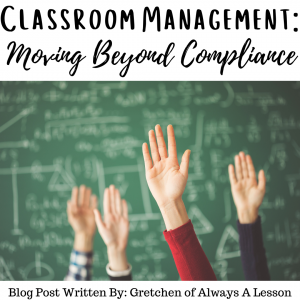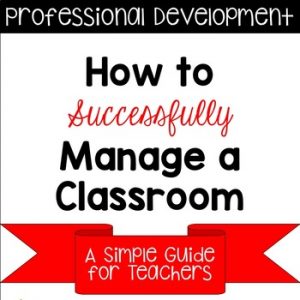Classroom Management: Moving Beyond Compliance
 Classroom management is not synonymous with behavior management. One is reactionary and one is preventive. Based on that fact alone, one is easily received and widely successful. Why is that so?
Classroom management is not synonymous with behavior management. One is reactionary and one is preventive. Based on that fact alone, one is easily received and widely successful. Why is that so?
When a student feels like they are under a microscope for every move they make (and don’t make), they put their guard up. This causes frustration to bubble up at every interaction. When a student is forced to comply with a set of pre-determined norms, they feel diminished under an authoritarian figure. As a result, students rebel in reaction rather than conform to the norm.
[spp-tweet tweet=”Managing a classroom helps teachers move beyond focusing on behavior (which they cannot control) to focusing on implementing structures (which they can control) so that students can be successful as learners.”]
It doesn’t mean that those structures cannot address appropriate expectations for student behavior, but the mode from which the teacher operates is to make the space and lesson structured to help students learn. Catching misbehaviors is not the priority when managing a classroom.
This post is the second in a series of posts (2 of 3) to help teachers grow one instructional strategy at a time. [Catch up on the previous post here.]
5 Tips for how to Manage a Classroom instead of Student Behavior
1st Tip: Classroom Management for Expectations & Responsibilities
Provide clear expectations for student responsibilities in your classroom. This sets the groundwork for WHAT students will accomplish during the year (responsibilities) and HOW they will ensure it happens (expectations). Look at overarching academic standards or goals and work backwards to create structures that support student growth. Students need to understand that it is their personal responsibility to get an education. To do so, they need to know what is expected of them for academics and behavior. When students know their role as learners and the outcome for what they are to achieve by the end of the year, they are much more focused on taking steps to get there. It’s as if the teacher provides a route overview from the start line to the finish line. It is much easier for students to see how their daily effort and work output helps them achieve the final goal when it is laid out in this manner.
2nd Tip: Classroom Management for Learning Areas
Provide structure for the learning areas in the classroom so that students know WHAT to accomplish as well as HOW/WHERE to do it. Not every nook and cranny needs to have a specific structure outlined; however, the details for those main areas that students frequent throughout the day should be finalized. As a cue, label the learning area (ie. reading nook, tech center, etc.). Then, post expectations in the learning area so students know how to operate within that space as responsible learners. These parameters can address volume level, checking in/out or logging in/out procedures, collaboration expectations, material use and storage, etc. Don’ forget to explicitly teach these expectations at the beginning of the year and then reinforce them throughout the year. Thinking through what students will do in the learning areas and how they will do them will help students achieve mastery.
3rd Tip: Classroom Management for Transitions
Students will transition numerous times within one individual lesson. Due to this frequency, it is important that students know how to move about the room. They might use hand signals to get out of their seat for various reasons or follow a particular path to move from learning area to learning area. Every transition should be planned to the detail and taught explicitly to students. (Note: You can use the same procedure in multiple subject areas or topics. You do not need to re-create the wheel!) A quiet, orderly transition ensures an efficient use of classroom time.
4th Tip: Classroom Management for Routines & Procedures
Decide what specific routines and procedures to implement into your classroom (ie. entering/exiting the classroom, turning in homework, retrieving materials, etc.). If the task is repeated on a daily basis, it needs to become a routined procedure. Think through the task from start to finish- What does it look like? What does it sound like? Where are students going? Where are students coming from? How should they complete the task? These questions will help you create routines and procedures so that students do more with less time and distraction.
5th Tip: Classroom Management for Differentiated Support
Set up structures in the classroom so that students can access a variety of learning supports (ie. dictionary, calculator, manipulatives, sight words, etc.). This also could look like a schedule for small groups posted near a meeting table with the ring of a bell signaling time to meet. Whatever the differentiated support is for students, it should be easily accessible without disturbing other learners.
The key for setting up structure for classroom management is to think through how to operate a successful lesson within the desired parameters. Aspects of instruction like volume, pace, location, format, and direction should be addressed so that students can consistently meet expectations. By structuring the classroom so that it supports learning increases the likelihood that students can become successful.
 First, grab some classroom management tools here. Then, snag the “How to Successfully Manage a Classroom” Guide by clicking the photo.
First, grab some classroom management tools here. Then, snag the “How to Successfully Manage a Classroom” Guide by clicking the photo.
Any educator that implements structures as a means to prevent misbehaviors and increase time on task, is on their way to reaching their potential in the classroom!
Go Be Great!
How do you move students beyond compliance in your classroom?

